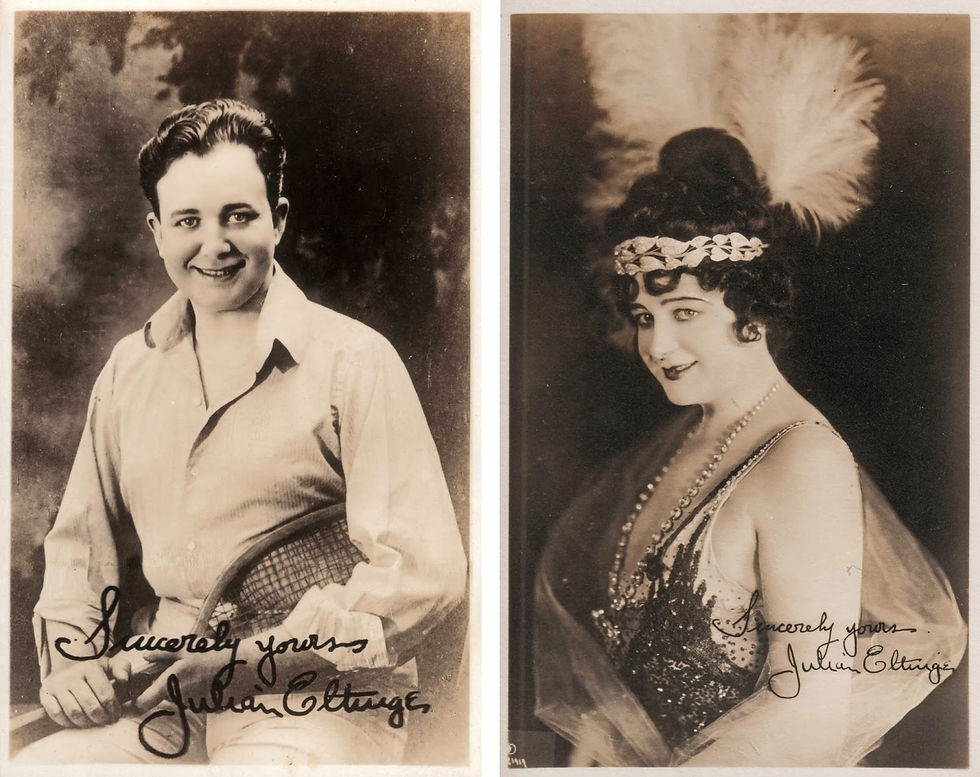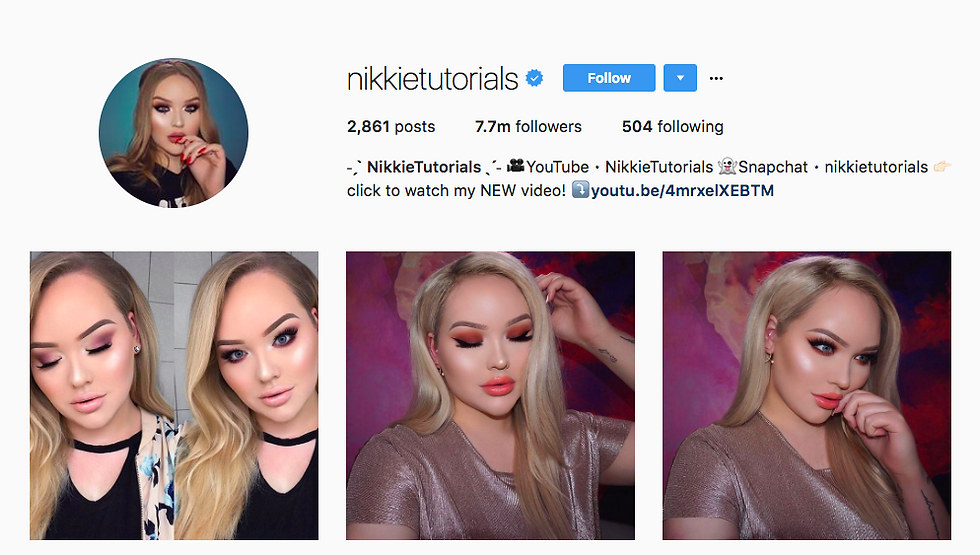Who Influences Who? Drag Makeup History and Trend Influence (Clara Radcliffe)
- keschmader
- May 12, 2021
- 5 min read
The influences of drag makeup and how drag influences today’s makeup trends.
We know that men originally performed as women in theatrical productions when women were not allowed to act (until the 1660s). However, men continued to act as or impersonate women far beyond that. Drag makeup tends to closely follow women’s makeup trends of the time, just exaggerated. One of the first prominent drag queens in American culture was Julian Eltinge in the 1910s/20s.

His makeup reflected the times: dark thin browns, dark heart-shaped lips, and a short curled hairstyle to match. His look began to become heavily exaggerated when he became an acclaimed Vaudeville performer, making it necessary for him to exaggerate his features so that his face could be seen from the back of the house. This, in turn, originated a drag makeup trend to last the century: exaggerated time period makeup. We see this in other drag performers as well throughout the years. At the times of the early 1900s all the way until around the 1970s, drag makeup trends were created because of a few factors: first, a drag performer recreates an exaggerated look he sees on a woman, or in a movie, then, the trend is spread by word of mouth by drag queens in underground bars all over America. Because drag queens were never shown on TV, and the internet did not exist yet, there was no way for trends to be spread except by learning directly from other drag queens in one’s own community. This all began to change in 1969, with the events of Stonewall. Drag queen Flawless Sabrina was at the forefront of the movement, and she was frequently featured on TV, being the first drag queen to appear on television in drag since it was criminalized. In the 70s, drag sensation Devine was the star of a series of movies called “The Trash Trilogy”, and later as Tracy’s mother in a screen adaptation of the musical Hairspray. She became a well-known drag icon, and popularized makeup trends like high, thin, and dark arched eyebrows, the cut-crease eyeshadow look, and long lashes, which became a staple in the drag community because so many queens were able to be exposed to the look. After the success of Devine, exponents of drag began to be highlighted in mainstream culture. Most notably in 90s stars such as David Bowie, Prince, and Tim Curry in Rocky Horror Picture Show. The drag makeup trends began a new trend during the 1980s when gay bars began to open in New York: makeup became even more exaggerated. This was due to drag queens livelihood now being on the stage in live performance, as it never had been before, therefore, faces were contoured and highlighted heavily to bring out face shape under harsh lights, colors were brighter, lashes were longer, lips were bigger so they were more prominent for lip syncing, “baking” was invented to make sure the heavy amounts of makeup stayed on through hours of wear and sweat, everything was bolder.
This all comes to a peak with the introduction of RuPaul in the 1990s. A major drag queen in the bar performance scene, he catapulted to fame with the hit of his song “Supermodel” (You Better Work). He then became a spokesperson with the makeup brand Mac in 1994, Mac wanted to create a collection to help those affected by the AIDS crisis, and they made RuPaul the face of the campaign. The fame of RuPaul caused a huge peak of interest in the drag community, but the media quickly lost interest. However, drag gained an extreme amount of popularity when RuPaul created “RuPaul’s Drag Race” in 2009. This show being aired on TV, featuring not just a singular queen, but many different queens, along with the popularity of the internet around this time caused the world of drag as a whole to be thrust into the spotlight. When RuPaul came back into the spotlight with this new show, she had a new look: a completely flawless face that other drag queens began to copy.

The creation of the platform YouTube 4 years before was timed perfectly for this, for now, drag queens all over America began posting tutorials for drag makeup looks, which had never been done before. Suddenly, drag queens could learn from other drag queens by video, instead of just seeing a look already done on a queen. Drag now had a new platform, other than just pictures on social media, and it gave them a way to teach millions of people how to do drag. Around this time is where we see the switch from drag being influenced by the decade’s makeup trends, to the decade’s makeup trends being influenced and created by drag trends.
In 2012, Kim Kardashian posted a YouTube video of her showing her contour routine.

Prior to this, contouring was not a thing in everyday makeup (the makeup of the 2000s was very minimal). Soon, women all over the world began adding contouring to their daily routines. Kim Kardashian’s makeup artist at this time has said that she learned about contouring from the drag world. This video inspired thousands of contouring tutorials and posts, by those who have become known as “influencers”, showing everyday women how to achieve “Kim’s look”. Other celebrities followed suit, and everyone began contouring and going bold in their makeup looks. This happened around the same time that social media began to completely blow up, and everyone wanted to look “picture perfect” all the time, like how drag queens do. Soon, we saw several drag techniques now part of the 2010s/2020s trends: cut-crease eyeshadow, baking, block brows, overlined lips, false lashes, contouring, highlighting, and bold colors.

Influencers began experimenting with crazier and crazier looks, competing with one another to get the most views, and posting tutorials of said looks. Now, we see that the majority of the credit for the makeup trends of today go to these influencers and celebrities, and the drag community does not get the credit it deserves. However, RuPaul bringing drag into mainstream culture, and this newfound pressure and enjoyment from looking perfect all the time on social media, has caused even more new interest in drag. Suddenly, there are more people trying drag than ever, and more nationwide acceptance than there has ever been. Drag absolutely deserves more credit for the makeup trends that the community gave this to create this decade’s “look”. It’s really cool to see how the drag community has gone from being inspired, to mostly being the inspiration. I hope that drag makeup begins to get more credit for our trends, and that it continues to evolve for the better.
Citations:
Giardina, Henry. “GAY L.A. –Crossdressing Tales of the ‘Ambisextrous’ Julian Eltinge.” The Pride LA, 18 Feb. 2019, thepridela.com/2019/02/gay-l-a-crossdressing-tales-of-the-ambisextrous-julian-eltinge/.
AllureMagazine. “‘RuPaul's Drag Race’ Cast Explains The History of Drag Culture | Allure.” YouTube, YouTube, 8 Feb. 2018, www.youtube.com/watch?v=MHlE3RIkRi0.
Krause, Amanda. “What the Ideal Face of Makeup Looked like over the Last 100 Years.” Insider, Insider, 25 Apr. 2019, www.insider.com/ideal-face-of-makeup-throughout-history-2019-4.
TheThings Celebrity. “How Drag Makeup Changed The Beauty Industry Forever.” YouTube, YouTube, 24 Dec. 2020, www.youtube.com/watch?v=OWO61bEmMrc.
Rodulfo Beauty Director Kristina Rodulfo is the Beauty Director of Women's Health—she oversees beauty coverage across print and digital and is an expert in product testing, Kristina. “Everything We Know About Beauty We Learned From Drag Queens.” ELLE, 12 Mar. 2021, www.elle.com/beauty/makeup-skin-care/a25426378/drag-influence-beauty-industry/.


Comments